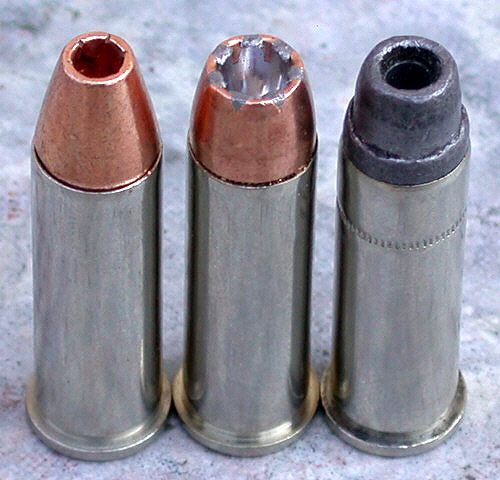
.38 Special Snub Ammo Test:
Corbon 110-gr. DPX vs. Speer 135-gr. Gold Dot vs. Remington 158-gr. LSWCHP+P
With today's plethora of compact 9mm's, .40's, and .45 autoloaders, there remains a contingent of people preferring the time-tried snub 38 revolver. Interest in the "best" loads for self-protection remains high and recommendations run from 148-gr. target full wadcutters to a myriad of standard pressure and +P loads.
An old standby for several decades has been the lead semiwadcutter hollow point offered by Federal, Remington, Winchester and others. "Old technology" to be sure, the old "FBI Load" still garners its fair share of advocates. This one has always been a +P load and is merely a lead hollow point shaped like a semiwadcutter with rounded edges.
Though there are other players to be sure, a couple of touted "new technology" loads are vying for the hearts of snub 38 fans as the top load for serious business.
One is from Corbon and is designated DPX for Deep Penetrating X-bullet. This +P load uses a solid copper alloy bullet made by Barnes. Their X-bullets have a following among rifle hunters for both reliable expansion as well as penetration that is deeper than bullet weight might suggest. X-bullets for rifles normally expand with 4 petals, which forming an "X", hence the name. Their pistol bullets have 6 petals but still are called by the same name.
X-bullet expansion is engineered through alloy composition as well as bullet shape, hollow cavity depth and width and there appears to be pre-stressing, a process with which I am not familiar. The .38 Special has a crimping groove. It is tightly seated and there was not the least indication of any X-bullets unseating in recoil.
Speer recently introduced a +P load designated specifically for snub revolvers. It is designated Speer 135-gr. GDHP +P, which stands for Gold Dot Hollow Point. It is a traditional jacketed hollow point having a more malleable bullet jacket than most JHP's and with its lead core chemically bonded to the jacket. This insures no fragmentation or loss of mass during expansion.

These three bullets range in weight from light-for-caliber to standard 158-gr. About all they have in common besides caliber is that they are hollow points. Each attempts to maximize terminal effectiveness through differnent construction. From left to right: Corbon 110-gr. DPX +P, CCI/Speer 135-gr. GDHP +P, and Remington 158-gr. LSWCHP +P.
Shooting: For testing these rounds, I opted to use my 24/7-carry gun, an S&W Model 642. It is a stock, pre-lock revolver possessing no special attributes and has the usual 1 7/8" barrel.
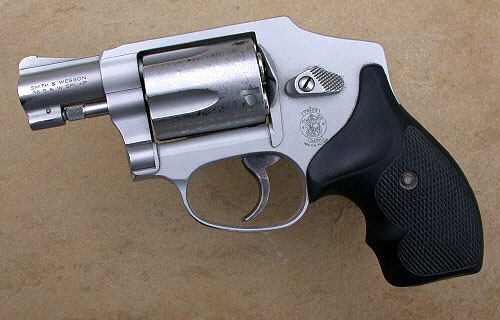
This S&W Model 642-1 was used for today's tests. It is stock and has been both carried and shot much over the years.
Shooting was done standing and with a two-hand hold. I fired only at 10 yards and did so in slow-fire. Though probably not replicating what might happen in a deadly force scenario, skill in rapid-fire is dependent upon the individual shooter. My purpose was to see how well this ammunition did or did not group. If it won't group in slow and deliberate fire, it will only do worse when rapidly shot and groups tend to be larger.
The following 10-yard targets consist of 5 shots each.
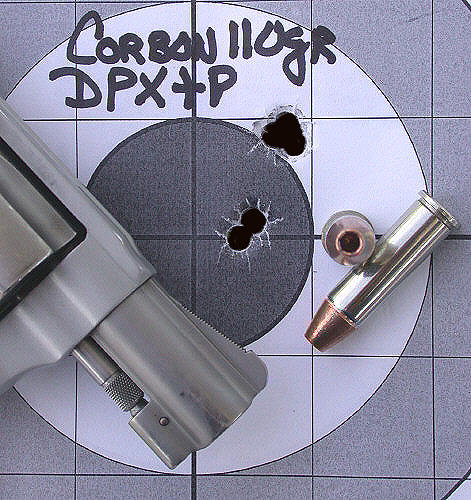
Point of aim was at the center of the bullseye. This load grouped plenty well for defensive purposes. The spread between the two and three-shot clusters are almost certainly due to human error.

Once again the point of aim was the center of the bullseye. Though probably luck, this was the best group of the day. I have had good accuracy with Speer Gold Dots in other calibers as well.
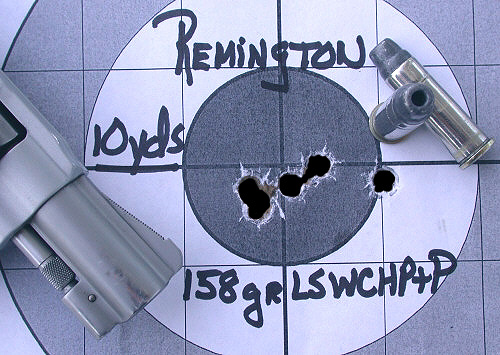
This has been my normal carry-load in the snub. It is the Remington 158-gr. LSWCHP +P. Point of aim was the bottom of the bullseye. The shot to the far right was from my error.
I believe that all three of the loads fired are capable of one-hole groups at 10 yards and that differences are primarily from the human error I introduced.
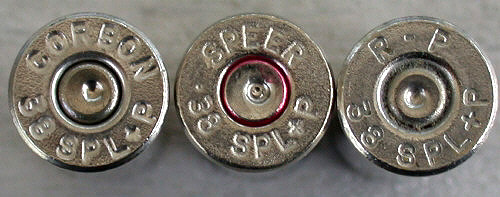
None of these +P loads showed any signs of flattened primers or excessive pressures for the revolver used. None of them exhibited any sticking during case extraction.
Velocity Results: The table below contains data based on 10 shots from each load fired 10' from the chronograph screens.
Chronograph Results (ft/sec):
|
Load: |
Average Velocity: |
Extreme Spread: |
Standard Deviation: |
|
Rem 158-gr. LSWCHP +P |
844 |
11 |
4 |
|
Speer 135-gr. GD +P |
921 |
39 |
17 |
|
Corbon 110-gr. DPX +P |
1164 |
45 |
17 |
I was a little surprised by the average velocity of the Remington. It normally clocks between 800 and 810 ft/sec for me. The ammo used today was from a new box recently purchased.
Expansion and Penetration Testing: In these informal tests, I used super-saturated newsprint that had been soaked for 24 hours prior to using. The bundle of "wetpack" was drained for 30 minutes before shooting. Five rounds from each load were fired into it from a measured 5' and average penetration and expansion data is presented.
Expansion results are quite similar to those from 10% ballistic gelatin, but bullets routinely penetrate less than in the gelatin.
Here is what shook out:
Penetration/Expansion Results
|
Load: |
Average Expansion (in.): |
Average Penetration (in.): |
|
Remington 158-gr. LSWCHP +P |
0.580 x 0.565 x 0.479 tall |
8 1/2 |
|
Speer 135-gr. Gold Dot +P |
0.531 x 0.549 x 0.459 tall |
7 1/2 |
|
Corbon 110-gr. DPX +P |
0.522 x 0.524 x 0.502 tall |
8 |
All of these loads are designed to penetrate at least the FBI-recommended 12" of 10% ballistic gelatin. From what I've read by those using 10% ballistic gelatin, the LSWCHP may or may not expand when fired through 4-layers of denim from a snub barrel. When fired into plain gelatin, it expands and penetrates between about 14 and 16". Corbon's 110-gr. DPX does about 13 to 14" after passing through 4-layers of denim and the Speer 135-gr. Gold Dot gets 13 to 14".

Here you can see two of each recovered bullet after being fired into the super-saturated newsprint. None failed to expand and results were very similar for each and every one. Left to right: Corbon 110-gr. DPX+P, Speer 135-gr. Gold Dot +P, and Remington 158-gr. LSWCHP +P. Weight loss was non-existent with any of them.
Observations: None of the three loads tried today "failed" in my admittedly limited and informal tests, but the question of which is best is not so easily answered. As far as I know, there have been no actual shootings of felons with any of the loads other than the older Remington. Despite its not passing the now-mandated 4-layers-of-denim-before-gelatin tests, it does appear to enhance the snub .38's "stopping power" on the street. Based on what I've seen in my own puttering around as well as read from "the big boys at the bicycle rack," both the DPX and Gold Dot should do at least as well and maybe better. I flat do not know the answer concerning which of the three is the supreme load for the pocket 38 revolver. Frankly, I wouldn't be afraid to load my personal carry gun with any of these loads.
Where the old LSWCHP has an actual "history", the DPX is garnering a reputation for consistency in expansion characteristics when fired through barriers ranging from denim, wallboard, laminated automobile windshields, and even light sheet steel. It is interesting to note that one is "old technology" and the other "new" but both are of homogeneous design, just of different materials. Speer's Gold Dot is reported to "pass" the denim test but I flat do not know how well it does or doesn't do after passing through hard targets and then impacting soft.
As I've mentioned before, felt recoil is a very subjective topic, but to me the Gold Dot had the sharpest felt recoil followed by the DPX and finally, the LSWCHP. None were pleasant, but neither was any "uncontrollable."
In a steel frame J-frame revolver, felt recoil would certainly be manageable in my opinion and this would just get better with the K-frames and larger. That said, felt recoil is significant enough in my view, that the lightweight snub remains a poor choice for those new to shooting.
All three of these loads were fired from an aluminum-framed S&W Airweight. These are about the lightest snubs in which non-jacketed ammunition can be used. If you have one of the newer S&W Airlight snubs, please note that S&W recommends only jacketed ammunition, thus the LSWCHP would not be an option. Trust me; non-jacketed lead bullets will unseat themselves from their cases from recoil in but a few shots. It would not be a problem with the DPX, Speer, or other jacketed hollow point. In the aluminum frame or all-steel snubs, any of these three would be fine.
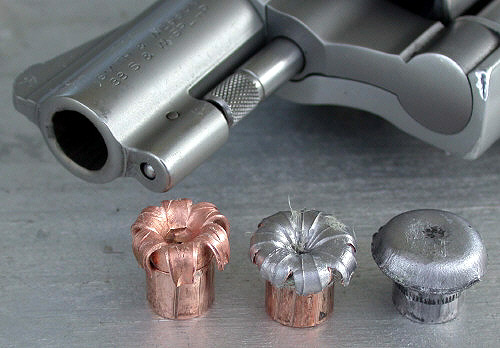
Which is the best? I don't know. I've cast my lot with the LSWCHP +P for more than a few years. Each of these bullets expanded reliably for me in my own informal tests. Against a non-barricaded aggressor at arm's length, I think any of these would suffice assuming that most important element of "stopping power": placement.
Best.